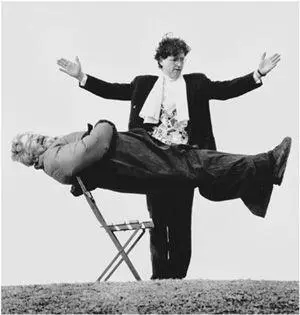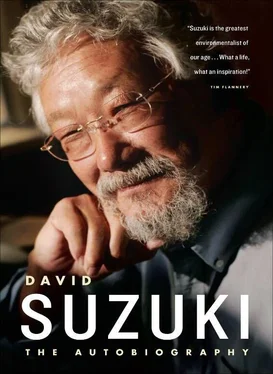For Science Magazine , producer John Bassett was doing a report on hypothermia and decided the best way for me to do a stand-up was in the ocean. But it was December, and although we shot it in Vancouver, which has a relatively mild climate, it was snowing that day. I was wearing street clothing, but underneath that I had a wet suit of vest and short pants. Since the mid 1960s I had been an avid scuba diver, and in British Columbia the best time is in winter, when the cold water is clear and visibility is excellent. So I knew what it felt like when a wet suit first filled with water.
But on this shoot, I had minimal protection for my torso and no hood, gloves, or booties. I was not prepared for the shock when I jumped in. The water sloshed onto my skin and literally took my breath away. I could barely gasp out the lines as I had memorized them, my teeth chattering and my breaths coming in spasms. I can't remember how many times I had to do the stand-up, but when I crawled out of the water, it took me hours to warm up.
By far the most disagreeable shoot was for The Sacred Balance , filmed in a gold mine just outside Johannesburg in South Africa. It was bad enough going two miles underground: I had worried for days about developing claustrophobia, because in a huge, packed crowd, I get panicky at being swept along. What would happen when I was so far below ground in dark, narrow tunnels? I think the fear of being regarded as a wimp was the major factor that got me through those two days of shooting. But the biggest discomfort was not the noise, confinement, or darkness, it was the heat. The rock was 120 degrees Fahrenheit, and the air was almost as warm. We were advised to drink at least a quart of water an hour, which I did without having to pee — the water simply poured out of our skin.
We were there for a fascinating story. Until very recently, it had been believed there was no life below a few hundred feet underground. Oil drills had kept clogging up with microbial contaminants, but over the years those were dismissed as having originated above ground. However, the persistence of such findings finally induced scientists to determine whether there was life at a deeper level than was then known.
We followed the scientist Tullis Onstott of Princeton University in Princeton, New Jersey, who had discovered life embedded in rocks deep underground. Now bacteria are found up to five miles deep and probably farther. (Writer/researcher and my sometime coauthor Holly Dressel's response when I told her about this was, “I always knew rocks are alive.”) What Tullis has discovered are bacteria that belong to entirely new groups of organisms, which may have been isolated hundreds of millions of years ago. They metabolize so slowly they may divide once every thousand years.
We were going to film a sequence in which I would assist Tullis as he took samples of water flowing out of the rocks. He would explain to me what he was doing and what he had found. As we hunkered in front of the camera, the heat was overwhelming; it was so hot that the camera had been taken down the day before to allow the fogged lenses to clear as the camera heated up. We shot for a few minutes, then all of us retreated about one hundred feet down the tunnel to where one of the ventilation ducts blew cooler air into the shaft. We cooled down, then rushed back to film for another couple of minutes, then fled back to the vent.
After we had done this for about an hour, I was beat and was relieved to be told my part was finished, so I could stay by that vent. But Tullis was the star of the piece and had to be there to the end. He was beginning to stumble over his lines, and I warned the producer to watch him because I was worried. Sure enough, Tullis passed out from overheating and had to be dragged to the vent of cool air. The collapse of a worker is a nightmare, because at least two others are required to pull him to cooler air, and the rescuers are at risk of overheating and collapsing themselves. Pretty dicey, but our dogged scientist survived to talk another day.
Sometimes I have to juggle several stand-ups in a shoot. I had remarried in 1972; my wife, Tara, was pregnant with our second child when, in 1983, filming started for A Planet for the Taking , the biggest television series I had ever been involved with. We had slotted in a three-week interval around the time the baby was due when I could be in Vancouver. The anticipated date for the baby's arrival came and went, and day after day the amount of time I would have available to stay home shrank.

A publicity shot with illusionist David Bens for a film on Martin Gardner called
“Mathemagician” for The Nature of Things with David Suzuki
We had three camera crews out filming at the same time, one in India, the other two in Europe, and I was absolutely needed to do the stand-ups because they would hold the entire series together. If I couldn't be there when filming was going on, I would have to be sent out with a crew later just to shoot stand-ups, and that would be terribly expensive. I kept getting messages from India asking when and where I was arriving there so I could be picked up. Finally, the day I was supposed to leave for India came and still no baby. Sarika arrived three days after that, so I stayed around for another two days and then flew to India, five days late.
I did my stand-ups in India over several days, then moved on to Europe, Egypt, and Israel before flying to Kenya, where producer Nancy Archibald was filming a sequence on baboons. At this point, I had not seen Tara or Sarika for over three weeks. Tara had received clearance from doctors to fly with Sarika (and three-year-old Severn) to meet me in England, where I would be shooting a segment on the mathematician Isaac Newton, so I had to leave Nairobi on a certain date. As you might imagine, I was very antsy to leave for England.
Three days before the day I was to meet my family in England, I met up with the crew in Kenya. We filmed a number of stand-ups, and the day before my departure, we were scheduled to film a series of stand-ups with the baboons in the background. Shirley Strumm, the baboon expert who was advising us for the filming, had assured us that once the baboons were awake, they would move and forage for food for two or three hours, then settle down in midmorning for a couple of hours, and that's when we could film our stand-ups. If all went well, I could be out of there by noon.
We had followed the troop of baboons until they bedded down for the night, so we knew where they were. The next morning, we woke very early when it was still pitch-dark and set out so we could follow the animals once they started to move; they would tolerate us in close proximity as long as we were unobtrusive and didn't look them in the eye. I had four long stand-ups to deliver, which meant a lot of material to memorize. As soon as we were on the trail, I began to go over and over my lines, feeling the pressure both because there were wild, unpredictable animals involved and because I just wanted to get the hell out of there and onto the plane.
As Shirley had predicted, the animals woke up in the dawn light and began to move in a leisurely way. Lugging all our gear, we followed them for a couple of hours, until they finally seemed to be settling down to rest and digest their food. Nancy whispered, “Okay, David, stand-up number 1.”
Rudi pushed me around so that the baboons were nicely arranged behind me as I concentrated on stand-up number 1 over and over again. Just as Rudi was ready to shoot, the animals would get up and shift around. We'd scramble to find another spot where they had settled. “Okay, number 4 this time,” Nancy instructed, and Rudi and I repeated the process.
Читать дальше



![David Jagusson - Devot & Anal [Hardcore BDSM]](/books/485905/david-jagusson-devot-anal-hardcore-bdsm-thumb.webp)









